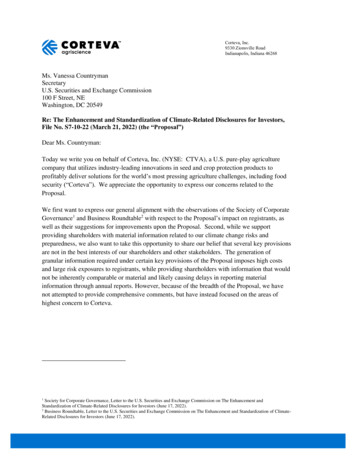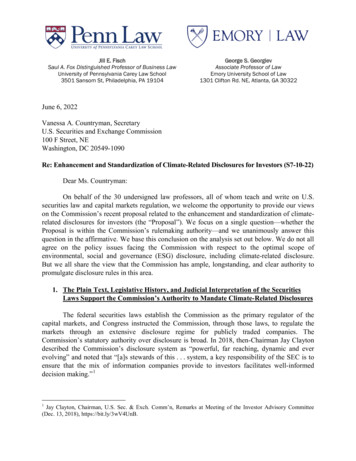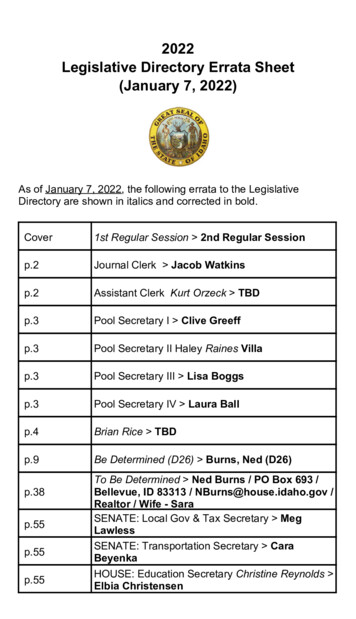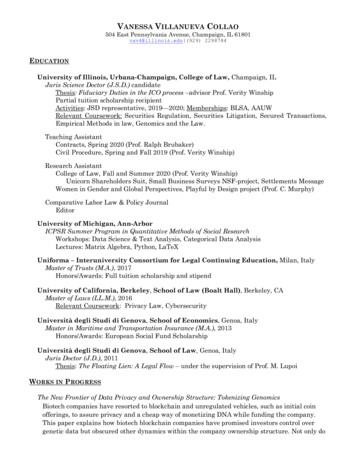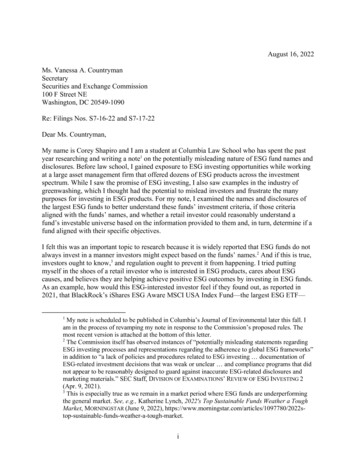
Transcription
August 16, 2022Ms. Vanessa A. CountrymanSecretarySecurities and Exchange Commission100 F Street NEWashington, DC 20549-1090Re: Filings Nos. S7-16-22 and S7-17-22Dear Ms. Countryman,My name is Corey Shapiro and I am a student at Columbia Law School who has spent the pastyear researching and writing a note1 on the potentially misleading nature of ESG fund names anddisclosures. Before law school, I gained exposure to ESG investing opportunities while workingat a large asset management firm that offered dozens of ESG products across the investmentspectrum. While I saw the promise of ESG investing, I also saw examples in the industry ofgreenwashing, which I thought had the potential to mislead investors and frustrate the manypurposes for investing in ESG products. For my note, I examined the names and disclosures ofthe largest ESG funds to better understand these funds’ investment criteria, if those criteriaaligned with the funds’ names, and whether a retail investor could reasonably understand afund’s investable universe based on the information provided to them and, in turn, determine if afund aligned with their specific objectives.I felt this was an important topic to research because it is widely reported that ESG funds do notalways invest in a manner investors might expect based on the funds’ names.2 And if this is true,investors ought to know,3 and regulation ought to prevent it from happening. I tried puttingmyself in the shoes of a retail investor who is interested in ESG products, cares about ESGcauses, and believes they are helping achieve positive ESG outcomes by investing in ESG funds.As an example, how would this ESG-interested investor feel if they found out, as reported in2021, that BlackRock’s iShares ESG Aware MSCI USA Index Fund—the largest ESG ETF—1My note is scheduled to be published in Columbia’s Journal of Environmental later this fall. Iam in the process of revamping my note in response to the Commission’s proposed rules. Themost recent version is attached at the bottom of this letter.2The Commission itself has observed instances of “potentially misleading statements regardingESG investing processes and representations regarding the adherence to global ESG frameworks”in addition to “a lack of policies and procedures related to ESG investing documentation ofESG-related investment decisions that was weak or unclear and compliance programs that didnot appear to be reasonably designed to guard against inaccurate ESG-related disclosures andmarketing materials.” SEC Staff, DIVISION OF EXAMINATIONS’ REVIEW OF ESG INVESTING 2(Apr. 9, 2021).3This is especially true as we remain in a market period where ESG funds are underperformingthe general market. See, e.g., Katherine Lynch, 2022′s Top Sustainable Funds Weather a ToughMarket, MORNINGSTAR (June 9, 2022), top-sustainable-funds-weather-a-tough-market.i
was more heavily invested in twelve fossil fuel stocks than the actual S&P 500?4 I sought todetermine if a retail investor could recognize from a fund’s disclosures that something like thiswas even a possibility, and more broadly, whether they could identify and understand howdifferent funds’ seemingly similar investing strategies could lead to dramatically different ESGoutcomes. I focused on retail investors because ESG funds are popular with retail investors, who,as the Commission knows, are an investing base which generally struggles to comprehendfinancial information, let alone information in a sector with a lack of standardized definitions andnorms.5 As retail investors (especially environmentally-conscious millennials) continue to investin ESG funds at record levels,6 it is important that funds’ disclosures position all investors tomake informed decisions.In my research, I analyzed the summary prospectuses of twenty ESG funds: ten ETFs and tenmutual funds. The twenty funds selected were the ten largest ESG funds by assets undermanagement in their respective categories.7 From this set, I developed a set of severalquantitative and qualitative takeaways and ultimately concluded that the ESG fund industry wasfailing to clearly name funds and disclose key information—which I labeled “the ESG fundlabeling problem.” Further, I considered the regulatory regime currently in place, led by theNames Rule, and concluded that it was not equipped to reign in ESG funds and the uniquechallenges they raise. In the original version of my note, I called on the SEC to introduceregulations to address the ESG fund labeling problem, with a particular focus on revising theNames Rule, as well as increasing ESG fund disclosures to limit the potential for investorconfusion surrounding misleading fund names and unclear disclosures.The proposed regulations take great measures toward resolving the ESG fund labeling problem. Ithink that, overall, the proposed rules will help investors’ understanding of ESG products, reduceinformation asymmetry and, in turn, lead to a fairer market. In particular, I believe theclassification of ESG funds into different categories will provide investors with a useful point ofcomparison about how a particular fund balances achieving ESG outcomes and financial returns.However, there are a few components of the proposed rules that I urge the Commission toreconsider before finalizing the rules:4Cam Simpson et al., The ESG Mirage, BLOOMBERG BUSINESSWEEK (Dec. 10, ottom-line/.5For instance, the CEO of the MSCI conceded that “ordinary investors piling into [ESG] fundshave no idea” how his company’s ratings methodology worked in that they do not focus on therisk the company presents to the world, but in reality, the other way around.” Id.6Allison Herren Lee, SEC Commissioner, Playing the Long Game: The Intersection of ClimateChange Risk and Financial Regulation, Keynote Remarks at PLI’s 52nd Annual Institute onSecurities Regulation (Nov. 5, 2020) (“There is really no historical precedent for the magnitudeof the shift in investor focus that we’ve witnessed over the last decade toward the analysis anduse of climate and other ESG risks and impacts in investment decision-making.”).7The sample set was not intended to be holistic, but to provide perspective on a retail investor’sexperience researching the largest ESG funds, which in theory, are consulted and relied on themost often.ii
(1) That ESG funds, or under the proposed taxonomy, ESG-Focus and Impact Funds,should be subject to the Names Rule’s 80% threshold requirement the way other funds are.I will first explain why the 80% requirement on its own does not fit ESG funds before proposinga reasonable alternative. I discuss both of the Commission’s related proposals together becausethe problem raised in one requires a solution in the other.The 80% requirement does not fit ESG funds because they are fundamentally different than allother types of investment opportunities. Why? Because many investors choose to put theirmoney in ESG funds for both financial and non-financial returns, something unique to thiscategory of investing. In other words, profit-maximization is not the only goal of many ESGinvestors, nor is it the sole objective of many ESG funds, which often claim to simultaneouslyachieve market returns and positive ESG outcomes. In fact, millennials’ interest in achievingESG objectives goes so far that an overwhelming majority—70%—would be willing to sacrificesome yield to achieve sustainable outcomes.8 Part of the willingness to sacrifice yield forpositive ESG outcomes is likely driven by “emotional drivers”9, i.e., the belief that sustainableinvestment opportunities can move the needle on ESG issues. For instance, 85% of millennialsbelieve their investment decisions could influence climate change, 44% of whom believed thisstrongly.10 The combination of investing for financial and non-financial reasons demonstrates theunique nature of ESG investing. It also explains why a rule created to regulate traditional profitonly funds does not work as well for ESG funds, which market themselves as achieving bothmarket and “extra-market” returns.11 Sections I.A.3 and I.B of my note, included below, explorethese ideas in depth and help show why rules created with a profit-maximization focus areinapposite for ESG funds.An example makes this even clearer. Put yourself in the shoes of the hypothetical ESG-interestedinvestor mentioned above, who is part of the 85% of millennials who believe their investmentscan influence climate change and the 70% who would be willing to sacrifice some financialreturns for a better environmental outcome; would they feel misled if the “ABC Fossil Fuel Free8Maintane Sardon, A Guarded Generation: How Millennials View Money and Investing, WALLST. J., (Mar. 13, 2020), Sally Hickey, Advisers need to tap into ESG emotional drivers, says Aviva, FIN. TIMES (May 24,2021), -aviva/.10Additionally, on the “S” front, 80% of respondents believed it was possible for theirinvestments to create economic growth to lift people out of poverty. MORGAN STANLEYINSTITUTE FOR SUSTAINABLE INVESTING, MORGAN STANLEY, SUSTAINABLE SIGNALS:INDIVIDUAL INVESTOR INTEREST DRIVEN BY IMPACT, CONVICTION AND CHOICE 4 (2019); seealso Ryan Clements, Why Comparability is a Greater Problem Than Greenwashing in ESGETFs, 13 WM. & MARY BUS. L. REV. 7 (forthcoming 2022) (arguing that ESG ETFs havebecome an increasingly popular product fueled by investor desire for meaningful social changeand a belief that investments can have a significant impact on a corporation’s decision-making).11Others have provided support for the idea that ESG investing has a “dramatically different”objective than other types of investing. See Eric C. Chaffee, Index Funds and ESG Hypocrisy, 75CASE W. RSRV. L. REV. 1295, 1304 (2021) (noting the goal of ESG investing is “dramaticallydifferent” than traditional index funds because the former is a form of principle-based investing,whereas the latter is profit-based).iii
Fund”—which they chose to invest in, both to seek market returns and to avoid environmentallyharmful companies—was just fossil-fuel free for 80% of the fund? And in the 20% of the fundnot subject to the Names Rule, ABC’s fund managers invested in the Carbon Majors12 theinvestor was specifically trying to avoid? In reality, this is not a fossil-fuel free fund, and it isdifficult to see how its name is not misleading.13In sum, the 80% investment allocation requirement does not work for ESG funds, and inparticular, ESG-Focus and Impact Funds, given the dual and often conflicting objectives manyinvestors have for investing in these funds. While such a threshold is appropriate for traditional,profit-maximization funds, it would be antithetical to many ESG investors’ “extra-market”expectations14 if an ESG fund left a sizable portion of the fund that was not adhering to itsinvestment criteria, or even worse, directly working against investors’ intentions and motivationsfor investing in the fund in the first place.With respect to a solution, it is unrealistic for most funds to achieve 100% compliance with thefund’s investing strategy. But funds that market themselves (and profit from doing so) asvehicles to achieve ESG outcomes should not be able to substantially invest in companies thatwork against the objectives their names purport to achieve. Therefore, a 90% and 95%requirement would be more appropriate for ESG-Focus and Impact Funds, respectively. Thesenumbers still give fund managers breathing room to manage their funds, while greatly limitingthe ability for funds to contradict their names and mislead investors.(2) Funds that invest in firms or funds that would not meet the fund’s investment criteriaought to make that explicitly clear to investors. A regulatory regime that only proscribes howfunds disclose their criteria for selecting investments that make it into the fund’s majority (i.e.,80%) strategy leaves investors unclear how a sizable portion of a given fund is invested. Underboth the current and proposed regimes, investors could be put in a position where they do notknow how 20% of a fund is managed. Put simply, it should be clear to investors when funds areinvesting in ways that are counter to their names and stated objectives. This will help both theprofit-driven ESG investor15 and the investor that is willing to sacrifice yield for positive ESGoutcomes identify which funds best align with their wide-ranging investing objectives.12See e.g., Press Release, Climate Accountability Inst., Carbon Majors: Update of Top TwentyCompanies 1965-2017, (Oct. 9, ressRelease%20Top20%20Oct19.pdf (“We findthat the Top Twenty [largest oil, gas, and coal companies] companies have collectivelycontributed 480 billion tonnes of carbon dioxide and methane, chiefly from the combustion oftheir products, equivalent to 35% of all fossil fuel and cement emissions worldwide since 1965.”).13There could even be a scenario where a fund, in an effort to earn competitive returns, overlevers into Energy-sector stocks, thus providing investors with disproportionate exposure to asector they sought to avoid in the first place.14See Ryan Clements, Why Comparability is a Greater Problem Than Greenwashing in ESGETFs, 13 WM. & MARY BUS. L. REV. 11 (forthcoming 2022) (noting that supporters ofsustainable investing see it as a way to positively enact social and environmental change).15This returns-focused investor, for instance, might be okay with a fund having significantexposure to companies that would not have been selected for the portfolio’s investment criteria.As such, they might choose a fund with significant exposure to Carbon Majors or lowGovernance firms for the potential profit.iv
To this end, I propose that all ESG-Focus and Impact Funds should be required to clearly andprominently state on their websites what percent of the fund is invested in securities that do notcomply with the investment criteria for the 80% portion of the fund, updated on a monthly basis.This monthly cadence will offer investors a somewhat frequent datapoint to consider whendeciding whether to invest (or remain) in a fund and provide fund managers ample time tocomply with the furnishing of this information. For example, if ABC’s Fossil-Fuel Free Fundactually has 2% of its portfolio in an Energy sector ETF, which is invested in securities thatwould not qualify for the fund’s 80%, they should disclose this to investors as the fund’s name istechnically no longer an accurate description of the fund.Moreover, I believe Impact Funds should comply with further requirements given the additionalextent they market themselves as focusing on positive ESG outcomes. Specifically: (a) ImpactFunds should be required to apply a “Best-in Class”16 strategy to any investments in the “20%part” of the fund so that exposure to undesired industries is limited to the “best of the worst”; and(b) an Impact Fund’s investment in any one non-complying company cannot be one of the fund’s25 largest holdings or comprise more than 2% of the total fund’s portfolio.These requirements provide benefits to both investors and asset managers. Investors are givenanother data point to compare funds to each other, which should facilitate investors selectingfunds that best match their objectives.17 And from a policy perspective, it will force funds todisclose a potentially undesirable datapoint, which, could incentivize them to invest in a mannerthat is more true to their names. For funds that are investing according to their investment criteriafor more than 80% of the fund, this datapoint gives them an opportunity to easily distinguishthemselves from competitors. In many respects, this is how Akerlof’s lemons model18 plays out:as sellers are able to provide more information to the market and information asymmetry isreduced, it becomes easier for investors to spot the lemons (and avoid them). In turn, the bestproducts on the market are bought, and in the funds context, will attract investors’ dollars.Below, I am including a truncated and revised version of my Note. I have removed non-relevantsections, and in particular, think it is worth the Commission considering: I.A.3 for a framework for explaining how ESG funds fall on a spectrum from being profitor ESG-outcome oriented. I think this will be helpful for your consideration of why it isso important for regulations to help investors identify where funds land across this wideranging spectrum.I.B provides research and information on the extent to which a large investor base caresabout the non-financial impact of their investments. This data underscores the extent towhich so many investors are leveraging investments to achieve non-financial benefits.16Best-in-Class Screening is the “investment in sectors, companies or projects selected forpositive ESG performance relative to industry peers.” GLOBAL SUSTAINABLE INVESTMENTALLIANCE, 2018 GLOBAL SUSTAINABLE INVESTMENT REVIEW 7 (2019).17Of note, this rule would help both investors looking to maximize impact as well as investorslooking to maximize yield find the funds that best match their specific goals.18Investopedia, Lemons Problem (Nov. 29, 2021) .asp.v
II.A contains several quantitative and qualitative takeaways that analyze the namingconventions and disclosures of the leading ESG funds using hand-collected data.II.B applies these takeaways alongside information on retail investors’ general financialknowledge and investing habits.In conclusion, I believe that the proposed regulations will help make the ESG fund industry aneasier space for retail investors to navigate, but could be further developed to better achieve thesegoals. Investors need the ability to identify which funds best match their investing objectiveswithout the underlying concern they are potentially being misled by confusing disclosures andmarketing tactics. I hope the Commission finds these comments helpful, and I thank you inadvance for your time and consideration.Sincerely,Corey Shapirovi
Green Funds in a Gray Area: An Analysis of the ESG Fund LabelingProblem in ActionCorey ShapiroAugust 16, 2022AbstractAmid record interest in ESG investing and investment in ESG funds, there has also never beenmore scrutiny of ESG funds and what they actually accomplish. Several former ESG industryleaders are sounding the alarm on ESG investing, calling it a deadly distraction from the realwork needed to achieve ESG outcomes, and in particular, to address the climate crisis. Theybelieve large asset managers are engaged in greenwashing, and investors are seriously beingmisled. The SEC has also found evidence of misleading fund names and disclosures, and hasproposed two rules to combat this issue.To answer whether ESG funds are living up to their purported hype, this Note analyzes proprietarydata collected from the twenty largest ESG funds (mutual funds and ETFs), and documents the“ESG fund labeling problem.” Namely, that ESG fund names are often vague or misleading, andthat funds’ disclosures do not clearly describe the funds’ ESG investment strategies.This version of the Note, submitted to the SEC, has been revised and shortened in light of theCommission’s two recent proposed rules. As such, certain sections are omitted as they are nolonger relevant.1
INTRODUCTION . 3I.ESG FUNDS, RETAIL INVESTORS, AND THE SEC’S REGULATION OF OPEN-END FUNDS . 8A. THE ESG FUND LANDSCAPE . 81.From SRI to ESG . 82.The Current ESG Landscape . 93.The Different ESG Investing Strategies . 12B. RETAIL INVESTORS, MILLENNIALS, AND THEIR ESG BELIEFS . 15C. THE ESG FUND REGULATORY LANDSCAPE . 18II.THE ESG FUND LABELING PROBLEM IN ACTION . 21A. AN INVESTOR’S EXPERIENCE RESEARCHING ESG FUNDS. 221.Summary Prospectuses Are Not So Summary . 232.ETF and Mutual Fund Naming Conventions . 243.A Review of the Principal Investment Strategies Sections . 264.The ESG Investment Strategies Utilized . 295.Funds’ Treatment of the Names Rule . 316.Where the Funds Land on the Return-Impact Spectrum . 327.A Potential Culprit for the ESG Fund Labeling Problem . 338.Reason for Further Concern. 35B. A PERFECT STORM: THE MISALIGNMENT BETWEEN RETAIL INVESTORS AND ESG FUND DISCLOSURES . 36CONCLUSION . 40APPENDIX . 412
INTRODUCTIONImagine the following: after hearing about a revolutionary change taking place within thebreakfast industry, you head down to your local supermarket to purchase one of these new,“healthy” cereals everyone is buzzing about. Upon entering the cereal aisle, you are paralyzed bythe number of options. The first cereal you see is “Cereal Co.’s Nutritious Cereal.” The next is“ABC’s Healthy Cereal,” and the third is “XYZ’s Health-Oriented Cereal.” To figure out thedifference between these three ostensibly similar cereals—and purchase the one that bestmatches your dietary goals—you read the back of the boxes.The first cereal box says the following: “We at Cereal Co. seek to deliver a nutritiousproduct that tastes great too. That’s why we created our ‘Nutritious Cereal.’” ABC’s cereal boxsays “Our ‘Healthy Cereal’ excludes artificial ingredients so customers can enjoy what they’reeating and lose weight too. At least 80% of the ingredients in our cereal are organic and GMOfree, and we have the highest rating possible from the leading organic cereal reviewer.” XYZ’scereal box says something equally vague: “XYZ’s ‘Health-Oriented Cereal’ has special healthbenefits derived from a proprietary cereal-making process that integrates healthy ingredients. Inrecognition of this approach, the U.S. Breakfast Association gave our cereal five spoons.”Looking lower on the boxes, each cereal states that to learn more about the cereal’snutritional information, you can scan the QR code on each box. The QR code takes you to a PDFcalled the “Summary of Cereal Information,” which is long, challenging to read, and filled withindustry jargon. Each cereal uses different terminology and metrics to describe its purportedhealth benefits, making it difficult, if not impossible, to compare them to each other.3
After reviewing the cereals to the best of your ability, you select one. It is not clearwhether you picked a cereal that aligns with your diet, or even a “healthy” cereal at all.1In many respects, retail investors2 face similar challenges when researching and investingin environmental, social, and governance (ESG)3 funds (and in particular, mutual funds4 andexchange-traded funds (ETFs)).5 Not only is it challenging for investors to compare funds toeach other or easily match their investing goals with a fund’s objectives given, among otherissues—the lack of standardized industry terminology, wide-ranging ESG investment objectivesand strategies, and lengthy and confusing disclosures—it is often unclear what being an ESGfund even means.6 For instance, in the same way one would expect a “healthy” cereal to be1Cf. Gary Gensler, Chairman, SEC, Prepared Remarks Before the Asset Management AdvisoryCommittee (July 7, 2021) (making a similar analogy between ESG terminology and differenttypes of milk).2The SEC defines a “retail investor” as “a natural person who seeks to receive or receivesservices primarily for personal, family or household purposes.” SEC, Form CRS RelationshipSummary; Amendments to Form ADV, Release Nos. 34-86032 & 032.pdf. Notably, this definition includes both currentand prospective investors because the SEC “thought it would be beneficial for all natural personsto receive information to facilitate their account choices.” Id. at 190. Applying this philosophy inthe context of this Note, any ESG-related regulatory action analyzed or proposed should facilitateboth current and prospective investors’ understanding of investment products.3Throughout this Note, “ESG” will be used a general term to include the many other terms thataddress similar concepts, such as “socially responsible,” “sustainable,” “responsible,” and“green.”4The SEC defines a mutual fund as an “open-end investment company that pools money frommany investors and invests the money in stocks, bonds, short-term money-market instruments,other securities or assets, or some combination of these investments.” SEC, MUTUAL FUNDS ANDETFS: A GUIDE FOR INVESTORS, OFFICE OF INVESTOR EDUCATION AND ADVOCACY 4.5ETFs “are SEC-registered investment companies that offer investors a way to pool their moneyin a fund that makes investments in stocks, bonds, other assets or some combination of theseinvestments and, in return, receive an interest in that investment pool.” Id. at 6.6“The cumulative breadth of possible ESG considerations is spectacular, and the level ofresulting subjectivity this entails for an asset manager or commercial index provider in choosingconstituent portfolio companies for an ETF index is tremendous.” Ryan Clements, WhyComparability is a Greater Problem Than Greenwashing in ESG ETFs, 13 WM. & MARY BUS. L.REV. 9 (forthcoming 2022).4
nutritious, an investor might assume that a fund labeling itself as an ESG fund would invest incompanies with stronger climate records; however, this often not the case.7There is mounting evidence that ESG funds are not delivering on their stated ESGobjectives,8 and the asset managers behind these funds are not meaningfully fulfilling theirpromises to consider stakeholders beyond shareholders.9 A key reason why ESG funds fail tochampion ESG causes is because they are not designed to: not only are 90% of stocks in the S&P500 eligible for inclusion in leading ESG funds,10 but fund managers do not create their ESGfunds to lead on ESG issues. For example, BlackRock’s iShares ESG Aware MSCI USA IndexFund, the largest ESG ETF, is more heavily invested in twelve fossil fuel stocks than the actual7See INFLUENCEMAP, CLIMATE FUNDS: ARE THEY PARIS ALIGNED? 2 (2021) (finding that 71%of ESG funds had negative Portfolio Paris Alignment scores, and 55% of climate-themed fundsreceived negative Paris Alignment scores. A negative Portfolio Paris Alignment score indicatesthat the securities within the fund are misaligned with global climate targets); see also RajnaGibson Brandon et al., Do Responsible Investors Invest Responsibly?, EUR. CORP. GOV. INST.June 2021, at 4 (finding that ESG funds in the U.S. that signed the Principles for ResponsibleInvestment pledge exhibited at best similar, if not significantly worse portfolio ESG scores thanuncommitted peers); the Principles for Responsible Investment is a global alliance of sociallyresponsible investors created in 2005 by United Nations Secretary-General Kofi Annan. Over3500 investors have signed the pledge, which allows an organization to “publicly demonstrate itscommitment to including environmental, social and governance (ESG) factors in investmentdecision making and ownership.” United Nations Principles for Responsible Investment, Becomea Signatory, -signatory/5946.article (lastaccessed March 16, 2022).8See generally Jonathan B. Berk & Jules H. van Binsbergen, The Impact of Impact Investing,(Working Paper No. 3981) (concluding that divestment strategies have had little impact oncorporate behavior and will likely have little impact going forward); see also Bernard Sharfman,Bernard S. Sharfman, The Illusion of Success: A Critique of Engine No. 1’s Proxy Fight atExxonMobil, 12 HARV. BUS. L. REV. ONLINE, art. 3, 2021, at 1 (arguing Engine No. 1’s successin getting candidates elected to ExxonMobil’s board was ineffective because the hedge
Investment Management announced that the SEC is developing a framework that divides ESG funds into two buckets: "integration" and "focus" funds.94 The former is for funds where ESG "is simply a consideration in the strategy."95 Importantly, these funds would not be allowed to use 92Supranote86Error! Bookmark not defined.at n.17.


